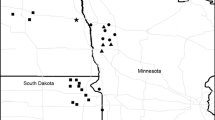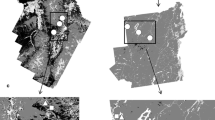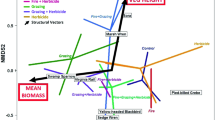Abstract
Freshwater wetlands and marshes with extensive reed beds are important hotspots of biological diversity, but in the absence of proper management, they are subject to biotic homogenisation. We assessed the impact of spatiotemporally variable management by cattle grazing (for 4 years) and late-summer burning (1 or 3 years before the study) on both songbirds and non-passerines in a previously homogeneous reed bed. We surveyed birds using a combination of line transects and point counts in a quasi-experimental design comprising six treatment levels. Management increased both the diversity of marsh habitats and the diversity of bird species. The species richness and abundance of non-passerines (ducks and geese, wading birds, gulls and terns, rails, coots and grebes) was higher in recently burned than in unburned or old-burned patches. Species richness of farmland songbirds was higher in grazed than in non-grazed patches, and the richness and abundance of reed songbirds was higher in unburned, old-burned, and grazed patches than in recently burned patches. Total Shannon diversity and evenness of birds was lowest in areas with the most intensive treatment (patches grazed and twice-burned), whereas Simpson diversity was highest in these areas. Non-managed patches had fewer species and individuals of all groups except reed songbirds. The proportion of old reed was low in recently burned and grazed patches, and was similarly high in all other treatment areas. No other property of reed stands was influenced by management, and both the allocation and the effect of management were independent of water level. Spatiotemporally variable management by cattle grazing and late-summer burning may thus simultaneously benefit several groups of birds. The effect of burning alone disappeared in 3 years, even in the presence of grazing; thus it must be repeated every 2–3 years. We conclude that both management actions are necessary to establish and maintain highly diverse habitats for marshland bird communities.
Zusammenfassung
Habitatmanagement im Wandel von Raum und Zeit: der Effekt von Grasen und Feuer-Management auf Vögel der Sümpfe
Süßwasser-Feuchtgebiete und Sümpfe mit ausgebreiteten Schilfbetten sind wichtige Hotspots biologischer Diversität, sind aber bei fehlendem vernünftigem Management betroffen von biotischer Verarmung. Wir untersuchten den Einfluss von raumzeitlich verschiedenem Management durch Grasen von Rindern (über vier Jahre) und Abbrand im Spätsommer (ein oder drei Jahre vor der Untersuchung) sowohl auf Singvögel als auch auf Nicht-Singvögel in einem zuvor homogenen Schilfbett. Wir zählten Vögel in einer Kombination aus Linien-Transekten und Punkt-Zählungen in einem quasiexperimentellen Design aus sechs verschiedenen Bedingungen. Ein Management führte zu einer höheren Diversität der Sumpfhabitate und einer gesteigerten Diversität an Vögeln. Artenreichtum und Abundanz von Nicht-Singvögeln (Enten und Gänsen, Limikolen, Möwen und Seeschwalben, Rallen und Taucher) war höher in kürzlich abgebrannten als in nicht abgebrannten oder vor längerer Zeit abgebrannten Flächen. Der Artenreichtum von Singvögeln des Weidelands war höher in Flächen mit grasenden Rindern, als in solchen ohne, und Singvögel von Schilfgebieten zeigten einen höheren Artenreichtum und Abundanz in nicht abgebrannten, vor längerem abgebrannten oder von Vieh beweideten Flächen als in kürzlich abgebrannten Flächen. Die totale Shannon Diversität und Äquität von Vögeln war am geringsten, die Simpson Diversität dagegen am höchsten bei der intensivsten Behandlung der Flächen (Flächen mit grasenden Rindern und zweimal abgebrannt). Nicht gemanagte Flächen hatten weniger Arten und Individuen aller Gruppen außer Singvögeln von Schilfgebieten. Der Anteil alten Schilfs war gering in kürzlich abgebrannten und beweideten Flächen und ähnlich hoch in allen anderen Behandlungsformen. Keine andere Eigenschaft des Schilfs wurde durch das Management beeinflusst, und sowohl die Verteilung als auch die Auswirkung des Managements waren unabhängig vom Wasserstand. Raumzeitlich unterschiedliches Management durch Beweidung und Abbrand im Spätsommer könnte daher gleichzeitig verschiedenen Gruppen von Vögeln von Nutzen sein. Der Effekt durch Abbrand allein verschwand innerhalb von drei Jahren auch bei gleichzeitiger Beweidung, so dass es alle 2–3 Jahre wiederholt werden sollte. Wir kommen zum Schluss, dass beide Managementmaßnahmen notwendig sind, um eine hohe Diversität von Habitaten für Vogelgesellschaften von Sümpfen zu erhalten.




Similar content being viewed by others
References
Ausden M, Hall M, Pearson P, Strudwick T (2005) The effects of cattle grazing on tall-herb fen vegetation and molluscs. Biol Conserv 122:317–326
Báldi A (2004) Area requirements of passerine birds in the reed archipelago of Lake Velence. Acta Zool Hung 50:1–8
Báldi A, Kisbenedek T (1998) Factors influencing the occurrence of Great White Egret (Egretta alba), Mallard (Anas platyrhynchos), Marsh Harrier (Circus aeroginosus), and Coot (Fulica atra) in the reed archipelago of Lake Velence, Hungary. Ekológia (Bratislava) 17:384–390
Báldi A, Kisbenedek T (2000) Bird species number in an archipelago of reeds at Lake Velence, Hungary. Glob Ecol Biogeogr 9:451–461
Báldi A, Moskát C (1995) Effect of reed burning and cutting on breeding birds. Paper presented at the integrating people and wildlife for a sustainable future. In: Bissonette JA, Krausman PR (eds) Proceedings of the first international wildlife management congress, Bethesda, Maryland, USA, pp 637–642
Benassi G, Battisti C, Luiselli L, Boitani L (2009) Area-sensitivity of three reed bed bird species breeding in Mediterranean marshland fragments. Wetl Ecol Manag 17:555–564
Bibby CJ, Burgess ND, Hill DA, Mustoe SH (2000) Bird census techniques, 2nd edn. Academic, London
Bobbink R, Beltman B, Verhoeven JTA, Whigham DF (2006) Wetlands: functioning biodiversity conservation and restoration. Springer, Berlin
Causarano F, Battisti C (2009) Effect of seasonal water level decrease on a sensitive bird assemblage in a Mediterranean wetland. Rend Lincei 20:211–218
Causarano F, Battisti C, Sorace A (2009) Effect of winter water stress on the breeding bird assemblages of a remnant wetland in Central Italy. Revue d’Écologia (Terre Vie) 64:61–72
Celada C, Bogliani G (1993) Breeding bird communities in fragmented wetlands. Bollettino di Zoologia 60:73–80
Christensen NL (1997) Managing for heterogeneity and complexity on dynamic landscapes. In: Pickett STA, Ostfeld RS, Shachak M, Likens GE (eds) The Ecological basis for conservation: heterogeneity, ecosystems, and biodiversity. Chapman & Hall, New York, pp 167–186
Connell JH (1978) Diversity in tropical rain forests and coral reefs: high diversity of trees and corals is maintained only in a non-equilibrium state. Science 199(4335):1302–1310
Connor EF, McCoy ED (2001) Species-area relationships. In: Levin SA (ed) Encyclopedia of biodiversity, vol 5. Academic, London, pp 397–411
Cross DH, Fleming KL (1989) Control of Phragmites or common reed. In: Cross DH, Wohs P (eds) Waterfowl management handbook. US, Fish Wildl Serv, pp 1–5
Déri E, Magura T, Horváth R, Kisfali M, Ruff G, Lengyel S, Tóthmérész B (2011) Measuring the short-term success of grassland restoration: the use of habitat affinity indices in ecological restoration. Restor Ecol 19:520–528
Ditlhogo MKM, James R, Laurence BR, Sutherland WJ (1992) The effects of conservation management of reed beds. I. The invertebrates. J Appl Ecol 29:265–276
Fuhlendorf SD, Engle DM (2001) Restoring heterogeneity on rangelands: ecosystem management based on evolutionary grazing patterns. Bioscience 51:625–632
Gibbons DW, Gregory RD (2006) Birds. In: Sutherland WJ (ed) Ecological census techniques, 2nd edn. Cambridge University, Cambridge, pp 308–344
Graveland J (1998) Reed die-back, water level management and decline of the Great Reed Warbler Acrocephalus arundinaceus in The Netherlands. Ardea 86:187–201
Graveland J (1999) Effects of reed cutting on density and breeding success of Reed Warbler Acrocephalus scirpaceus and Sedge Warbler A. schoenobaenus. J Avian Biol 30:469–482
Gregory RD, Gibbons DW, Donald PF (2004) Bird census and survey techniques. In: Sutherland WJ, Newton I, Green RE (eds) Bird ecology and conservation. Oxford University, Oxford, pp 35–40
Groom MJ, Meffe GK, Carroll CR (2006) Principles of conservation biology. Sinauer Associates, Sunderland
Hardman CJ, Harris DB, Sears J, Droy N (2012) Habitat associations of invertebrates in reedbeds, with implications for management. Aquatic Conserv 22:813–826
Hartnett DC, Hickman KR, Fischer WLE (1996) Effects of bison grazing, fire, and topography on floristic diversity in tallgrass prairie. J Range Manag 49:413–420
Kelemen J (2002) Védett és érzékeny természeti területek mezőgazdálkodásának alapjai (Fundamentals of agriculture on protected and sensitive natural areas). In: Ángyán J, Tardy J, Vajnáné Madarassy A (eds) Legeltetés (Grazing). Mezőgazda Kiadó, Budapest, pp 380–394
Korner I (2013) Long term monitoring of grazing in salt habitats on the eastern shore of Lake Neusiedl. In: Paper presented at the conference volume, 5th Symposium for research in protected areas, Mittersill
Lengyel S, Varga K, Kosztyi B, Lontay L, Déri E, Török P, Tóthmérész B (2012) Grassland restoration to conserve landscape-level biodiversity: a synthesis of early results from a large-scale project. Appl Veg Sci 15:264–276
Lockwood JL, McKinney ML (2001) Biotic homogenization: a sequential and selective process. In: Lockwood JL, McKinney ML (eds) Biotic homogenization. Kluwer Academic/Plenum, New York, pp 1–17
Lougheed VL, McIntosh MD, Parker CA, Stevenson JR (2008) Wetland degradation leads to homogenization of the biota at local and landscape scales. Freshw Biol 53:2402–2413
Magurran AE (2004) Measuring biological diversity. Blackwell, Oxford
Magurran AE, McGill BJ (2011) Biological diversity: frontiers in measurement and assessment. Oxford University, New York
Margoluis R, Stem S, Salafsky N, Brown M (2009) Using conceptual models as a planning and evaluation tool in conservation. Eval Prog Plan 32:138–147
McCabe DJ, Gotelli NJ (2000) Effects of disturbance frequency, intensity, and area on assemblages of stream macroinvertebrates. Oecologia 124:270–279
Mérő TO, Žuljević A, Varga K, Bocz R, Lengyel S (2014) Effect of reed burning and precipitation on the breeding success of Great Reed Warbler, Acrocephalus arundinaceus, on a mining pond. Turk J Zool 38:622–630
Moga CI, Öllerer K, Hartel T (2010) The effect of reed burning on the habitat occupancy of passerine species. North-West J Zool 6:90–94
Neto JM (2006) Nest-site selection and predation in Savi’s Warblers Locustella luscinioides. Bird Study 53:171–176
Nummi P, Paasivaara A, Suhonen S, Pöysa H (2013) Wetland use by brood-rearing female ducks in a boreal forest landscape: the importance of food and habitat. Ibis 155:68–79
Pan X (2013) Fundamental equations for species-area theory. Sci Rep 3:1334. doi:10.1038/srep01334
Paracuellos M, Tellería JL (2004) Factors affecting the distribution of a waterbird community: the role of habitat configuration and bird abundance. Waterbirds 27:446–453
Perrins C, Cramp S (1998) The birds of the western Palearctic CD-ROM. Oxford University Press, Oxford
Poulin B, Lefebvre G (2002) Effect of winter cutting on the passerine breeding bird assemblage in French Mediterranean reedbeds. Biodivers Conserv 11:1567–1581
Poulin B, Lefebvre G, Mauchamp A (2002) Habitat requirement of passerines and reedbed management in southern France. Biol Conserv 107:315–325
Pöysa H, Vaananen V-M (2014) Drivers of breeding numbers in a long-distance migrant, the Garganey (Anas querquedula): effects of climate and hunting pressure. J Ornithol 155:679–687
Rácz IA, Déri E, Kisfali M, Batiz Z, Varga K, Szabó G, Lengyel S (2013) Early changes of orthopteran assemblages after grassland restoration: a comparison of space-for-time substitution versus repeated measures monitoring. Biodivers Conserv 22:2321–2335
Redolfi De Zan L, Battisti C, Carpaneto GM (2010) Effect of spring water stress induced by fishery farming on two duck species Anas platyrhynchos L. and Anas crecca L. in a Mediterranean wetland. Pol J Ecol 58:599–604
Salafsky N, Salzer D, Stattersfield AJ, Hilton-Taylor C, Neugarten R, Butchart SHM, Collen B, Cox N, Master LL, O’Connor S, Wilkie D (2008) Standard lexicon for biodiversity conservation: unified classification of threats and actions. Conserv Biol 22:897–911
Salafsky N, Butchart SHM, Salzer D, Stattersfield AJ, Neugarten R, Hilton-Taylor C, Collen B, Master LL, O’Connor S, Wilkie D (2009) Pragmatism and practice in classifying threats: reply to Balmford. Conserv Biol 23:488–493
Schmidt MH, Lefebvre G, Poulin B, Tscharntke T (2005) Reed cutting affects arthropod communities, potentially reducing food for passerine birds. Biol Conserv 121:157–166
Schweiger EW, Leibowitz SG, Hyman JB, Foster WE, Downing MC (2002) Synoptic assessment of wetland function: a planning tool for protection of wetland species biodiversity. Biodivers Conserv 11:379–406
Schwilk DW, Keeley JE, Bond WJ (1997) The intermediate disturbance hypothesis does not explain fire and diversity pattern in fynbos. Plant Ecol 132:77–84
Tanneberger F, Tegetmeyer C, Dylawerski M, Flade M, Joosten H (2009) Commercially cut reed as a new and sustainable habitat for the globally threatened aquatic warbler. Biodivers Conserv 18:1475–1489
Vadász C, Német Á, Biró C, Csörgő T (2008) The effect of reed cutting on the abundance and diversity of breeding passerines. Acta Zool Hung 54:177–188
Valkama E, Lyytinen S, Koricheva J (2008) The impact of reed management on wildlife: a meta-analytical review of European studies. Biol Conserv 141:364–374
van der Toorn J, Mook JH (1982) The influence of environmental factors and management on stands of Phragmites australis. II. Effects of burning, frost and insect damage on shoot density and shoot size. J Appl Ecol 19:477–499
van Deursen EJM, Drost HJ (1990) Defoliation and treading by cattle of reed Phragmites australis. J Appl Ecol 27:284–297
Vásárhelyi T (1995) Nature conservational aspects of reedbed management. In: Vásárhelyi T (ed) Nádasok élővilága (Biota of reedbeds). Hungarian Natural History Museum, Budapest
Vinton MA, Hartnett DC, Finck EJ, Briggs JM (1993) Interactive effects of fire, bison (Bison bison) grazing, and plant community composition in tallgrass prairie. Am Midl Nat 129:10–18
Vulink JT, Drost HJ, Jans L (2000) The influence of different grazing regimes on Phragmites and shrub vegetation in the well-drained zone of a eutrophic wetland. Appl Veg Sci 3:73–80
Wagner KI, Gallagher SK, Hayes M, Lawrence BA, Zedler JB (2008) Wetland restoration in the new millennium: do research efforts match opportunities? Restor Ecol 16(3):367–372. doi:10.1111/j.1526-100X.2008.00433.x
Wheeler BD, Shaw SC, Fojt J, Robertson RA (1995) Restoration of temperate wetlands. Wiley, New York
Wiens JA (1997) The emerging role of patchiness in conservation biology. In: Pickett STA, Ostfeld RS, Shachak M, Likens GE (eds) The ecological basis for conservation: heterogeneity, ecosystems, and biodiversity. Chapman & Hall, New York, pp 93–107
Zacchei D, Battisti C, Carpaneto GM (2011) Contrasting effects of water stress on wetland-obligated birds in a semi-natural Mediterranean wetland. Lake Reserv Manag 16:281–286
Acknowledgments
We thank Hortobágy National Park for supporting the study. Large-scale habitat management was conducted in an EU LIFE-Nature project (LIFE04NAT/HU/000114, life2004.hnp.hu, Lengyel et al. 2012). The study was funded by three grants from the National Scientific Research Fund of Hungary (OTKA NNF 78887, NNF 85562, K 106133) to SL. We thank C. Battisti, T. Gottschalk, and an anonymous reviewer for helpful comments on earlier versions of the manuscript.
Conflict of interest
The authors each declare that they have no conflicts of interest.
Author information
Authors and Affiliations
Corresponding author
Additional information
Communicated by T. Gottschalk.
Electronic supplementary material
Below is the link to the electronic supplementary material.
10336_2015_1202_MOESM1_ESM.doc
Additional supplementary material may be found in the online version of this article: Supplementary Material Methods: Management needs: previous history, Fig. S1 Supplementary Material Results: Table S1, Table S2, Fig. S2 (DOC 1648 kb)
Rights and permissions
About this article
Cite this article
Mérő, T.O., Lontay, L. & Lengyel, S. Habitat management varying in space and time: the effects of grazing and fire management on marshland birds. J Ornithol 156, 579–590 (2015). https://doi.org/10.1007/s10336-015-1202-9
Received:
Revised:
Accepted:
Published:
Issue Date:
DOI: https://doi.org/10.1007/s10336-015-1202-9




